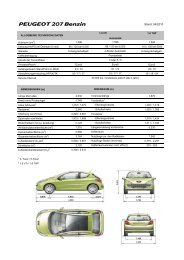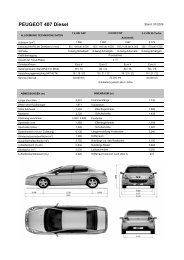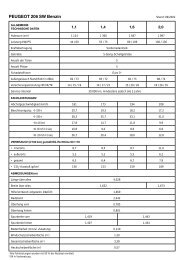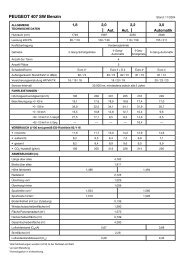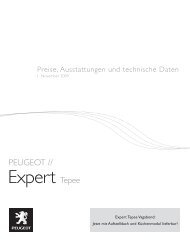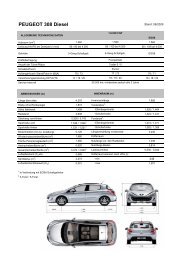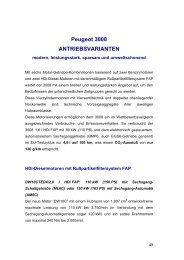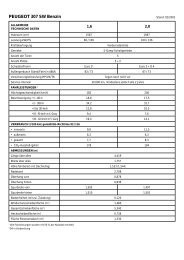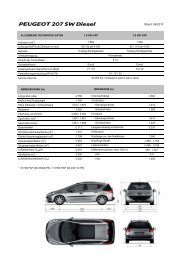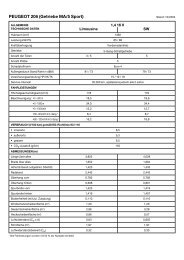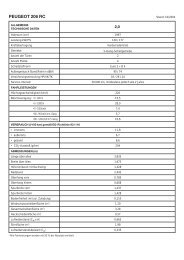PSA COUV page . page RA GB - PEUGEOT Presse
PSA COUV page . page RA GB - PEUGEOT Presse
PSA COUV page . page RA GB - PEUGEOT Presse
You also want an ePaper? Increase the reach of your titles
YUMPU automatically turns print PDFs into web optimized ePapers that Google loves.
Growth Strategy<br />
Corporate<br />
Governance<br />
Business Review<br />
Corporate Policies<br />
Management’s<br />
Discussion<br />
and Analysis<br />
Statistics<br />
systems. These systems—known as variable<br />
valve timing (VVT), variable valve lift system<br />
and timing (VVL), or Valvetronic—adjust<br />
the timing and degree of valve opening<br />
instantly to optimize cylinder filling and<br />
increase engine efficiency.<br />
Longer-term, the logical outcome of this<br />
research will be the camless engine, in<br />
which throttle valves will be operated by a<br />
computer-controlled electromagnetic or<br />
electrohydraulic system, instead of a<br />
camshaft. With this technology, the throttle<br />
valve and related pumping losses will be<br />
eliminated, thereby directly reducing fuel<br />
consumption—and with it CO 2 emissions—<br />
by as much as 10% compared with existing<br />
engines.<br />
DIRECT GASOLINE INJECTION FOR<br />
INCREASED FUEL ECONOMY<br />
<strong>PSA</strong> Peugeot Citroën is also conducting<br />
research into direct gasoline engine injection<br />
that, like the camless engine, would<br />
eliminate pumping losses linked to the<br />
throttle valve. Another area of study is<br />
stratified combustion, based on the<br />
observation that a slightly richer air-fuel<br />
mixture is needed for ignition than in other<br />
parts of the combustion chamber. If<br />
differentiated combustion regions can be<br />
created on a sustainable basis, the fuel<br />
mixture could be kept as lean as possible<br />
to minimize fuel consumption. These<br />
technologies could reduce consumption by<br />
around 5%.<br />
HYBRID VEHICLES, AN EMERGING<br />
TECHNOLOGY<br />
To reduce fuel consumption, hybrid vehicles<br />
combine two sources of energy, an internal<br />
combustion engine and an electric motor.<br />
In June 2002, <strong>PSA</strong> Peugeot Citroën and<br />
Electricité de France (EDF) signed a<br />
cooperation agreement to develop electric<br />
and hybrid vehicles and to step up research<br />
into associated technologies. Both partners<br />
place great importance on expanding the<br />
use of environmentally friendly automobiles,<br />
in particular among owners of electric<br />
vehicle fleets, such as public authorities,<br />
communities, and companies.<br />
The main challenge for the future is<br />
batteries, whose size, cost and volume can<br />
all be improved. The next hybrid electrical<br />
applications will be based on nickel-metalhydride<br />
batteries. In the longer term,<br />
though, lithium-ion batteries will overtake<br />
them, since they potentially offer a better<br />
energy/power ratio for equivalent volume<br />
and a lower objective cost, after adjustments<br />
to vehicle architecture.<br />
The Group is taking a pragmatic, prudent<br />
approach to three types of hybrid vehicle:<br />
- Stop and Start vehicles, which cut the<br />
engine whenever the car stops. By<br />
eliminating the idling phase, this solution<br />
<strong>PSA</strong> <strong>PEUGEOT</strong> CITROËN - MANAGING BOARD REPORT 93




